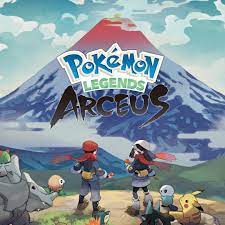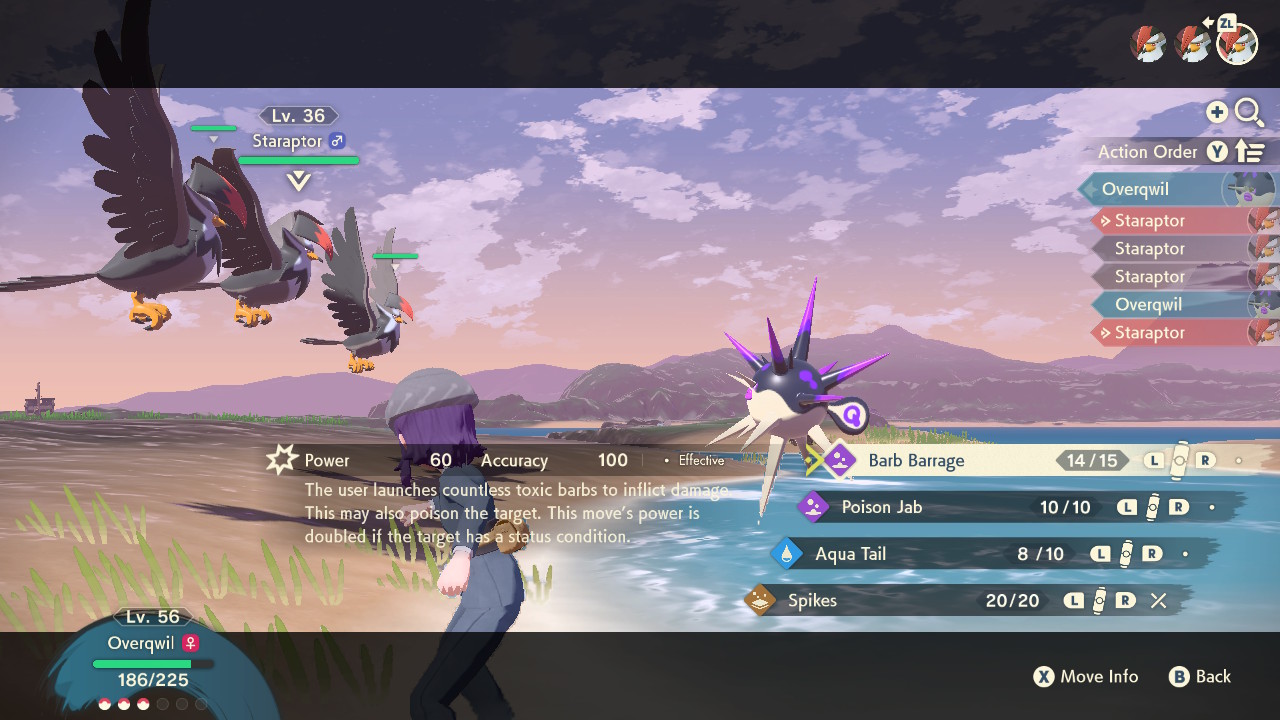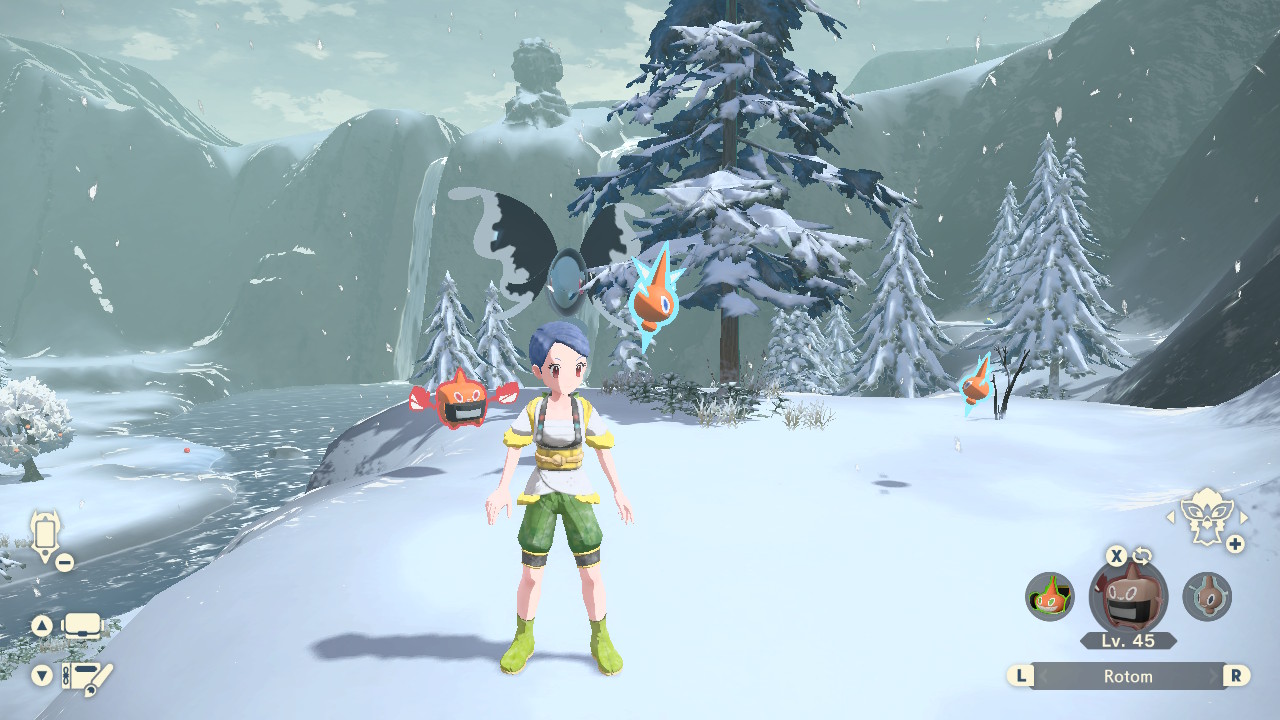Search
[{{{type}}}] {{{reason}}}
{{/data.error.root_cause}}{{{_source.title}}} {{#_source.showPrice}} {{{_source.displayPrice}}} {{/_source.showPrice}}
{{#_source.showLink}} {{/_source.showLink}} {{#_source.showDate}}{{{_source.displayDate}}}
{{/_source.showDate}}{{{_source.description}}}
{{#_source.additionalInfo}}{{#_source.additionalFields}} {{#title}} {{{label}}}: {{{title}}} {{/title}} {{/_source.additionalFields}}
{{/_source.additionalInfo}}- Details
- Category: Switch
- By Cinque Pierre
- Hits: 2110
Pokemon Legends: Arceus (Switch)

Pokemon Legends: Arceus
Developed By: Game Freak
Published By: Nintendo; The Pokemon Company
Released: January 28, 2022
Available: Switch
Genre: Action-Role Playing
ESRB Rating: E for Everyone: Mild Fantasy Violence
Number of Players: Single player
Price: $59.99
(Amazon Affiliate Link)
About four or so years have passed since mainline Pokemon games have been present on the Nintendo Switch. We’ve had two remakes in Pokemon Let's Go Pikachu & Eevee, and Brilliant Diamond & Shining Pearl. We had the Generation 8 games in Sword & Shield, as well as the first instance of DLC for the mainline games. Pokemon Legends: Arceus aims to shake things up by not following most of the traditional methods that the typical entries have done before, as well as only being a singular entry instead of a pair. This game begins as many Pokemon games do. You choose between a boy or a girl (officially named Rei or Akari) and their four variants that differ in hair and skin color. (Hair color can be changed later in the game whereas skin color cannot). The player will find themselves about a hundred or so years in the past when Sinnoh looked vastly different and was referred to as Hisui. After a few cutscenes, tutorials, exposition, and choosing your starter Pokemon, you’ll end up in Jubilife Village which acts as the central hub area. To be considered part of the village, you are more or less forced into joining the Team Galaxy Survey Corps, whose job is to bridge the gap between human and Pokemon relations. In Hisui, humans and Pokemon aren’t so buddy-buddy. Pokemon are pretty hostile towards people, and Pokeballs are just a very recent invention so the amount of Pokemon trainers in any given area can typically be counted on one hand. In the wild, Pokemon can and will attack you. Blacking out has consequences as you can only carry a limited number of items at any given time before storing them away and you’ll lose a random amount in your satchel before being carried away to safety. Pokemon in the wild interact in many ways. Some are pretty curious to the player and will generally allow themselves to be captured easily. Others are skittish and will run away as soon as the player is spotted. And some are aggressive and will target the player with their attacks. There are even some behaviors exclusive to specific Pokemon. For a first, the player can outright dodge attacks and you’ll need to do plenty of those as hostile Pokemon will chase you down. The different behaviors of each Pokemon do a good job in making you consider each action as you’ll be sneaking through the grasses to throw Pokeballs at unsuspecting creatures. The Survey Corps must go into the wild and research Pokemon. The main goal is to expand the Pokedex, which has taken a different approach. It isn’t just sufficient to catch the Pokemon, but there are also research tasks to be done as well, such as catching several Pokemon, feeding them food, or even seeing them use specific moves in battle. The gameplay loop is similar to Monster Hunter, consisting of choosing between numerous semi-open environments that are home to dozens of Pokemon. Plains, swamps, mountains, and snowy tundras are just some of the areas you’ll come across in your expedition. Every area has a frenzied Noble Pokemon that must be quelled before unlocking the next area. These Pokemon are battled differently than any other Pokemon as the goal is to whittle down their health with special balms while you dodge their attacks in an arena-like area.

Strong Points: Catching mechanics are better than ever; improvement on Pokemon models and animations; exploring the environment and interacting with the Pokemon is a joy; quality of life enhancements on the user interface
Weak Points: Mediocre environmental graphics; some of the optional requests and its mechanics can be tedious
Moral Warnings: Fantasy violence; player character “Akari” begins the game with short shorts; ghost-type Pokemon reference spirits/supernatural elements; some Pokemon are revered as gods/deities and the Diamond & Pearl clans each have a Pokemon they worship that they call “Almighty Sinnoh”
As Pokemon can be captured outside of the battle system, capturing mechanics have seen big changes. Now that the player physically throws the ball, weight, trajectory, and where the Pokeball even hits the Pokemon are all taken into consideration for a successful capture. It’s similar to the capture mechanics in Pokemon GO and Let's Go, but made improvements to it. Capturing is fast-paced and immersive—as well as something that I would like to see in future installments. I believe this is something Game Freak wanted for a long time but was never really able to do due to hardware limitations. Battles on the other hand, also have been changed considerably, but are less of a focus in PLA. It still uses a turn-based formula, but now it’s more along the lines of other JRPGs where speed now determines the order in which Pokemon act. There is no more simultaneous action like how the other Pokemon games are. In addition, there is a new mechanic called styles. Your Pokemon can choose between strong-style and agile-style. Strong-style increases the damage of your moves but can potentially lower your turn order, while agile style does the opposite. Using each style adds some depth to the new system. Since turns don’t happen simultaneously anymore, you have to consider if it’s worth it to use a strong-style move if the next Pokemon can come in and effectively get two or more turns on you before you’re able to react. The menu interface has seen improvements too, with menus in battle being accessed by the simple press of a button instead of slowly navigating through dozens of submenus. Battles themselves are speedy too with the majority of them taking no longer than six turns combined. I found it strange that despite the battle system changing a lot, in the end, I ended up preferring the original due to a multitude of reasons. For one, there are only a dozen or so mandatory battles throughout the entire game so the player rarely gets the opportunity to see the new system fully realized. Pokemon abilities have also been removed, and the number of moves substantially reduced/changed. There are no more interesting moves like Spite that reduce the PP of a move, instead of falling into a more streamlined system. Buffs, debuffs, general damage moves, and moves that do damage over time are what consist of the majority of the moves available. I do feel that status effects were changed for the better, such as sleep and freeze becoming drowsy and frostbite respectively. They now act more like paralysis where they decrease a stat and give the chance of an inactive turn instead of outright immobilizing a Pokemon for a random amount of time. Also, all buffs/debuffs and status effects are now temporary lasting two turns at minimum or six turns at max.
Now whereas the Pokemon modes have improved for the better, I think the environment has taken a turn for the worse. PLA went for a specific style, matching a watercolor aesthetic matching the looks of the Meiji era. (Or at least I think that’s it. I’m not well versed in Japanese history like that.) In my opinion, I just don’t think it worked out. The textures of the environment are low-quality, and the egregious pop-in of models, unfortunately, make the game look ugly. It’s such a shame because the models of the Pokemon look good, but the things surrounding them don’t. The fact that what you’re mostly doing in the game is capturing Pokemon, fulfilling Pokedex requirements, accomplishing quests, and looting makes the areas stand out even worse as there are very few puzzles or side areas within them. In terms of music, many of the pieces are remixes of existing music from (Brilliant) Diamond & (Shining) Pearl and I’d say a lot of them are well done. Some take an approach that uses some classical Japanese string instruments and others enhance the existing instruments in the original piece. Battle themes in particular are dynamic and high energy, concepts that they have played around within Black & White and Sword & Shield, but seem to be sticking around for the foreseeable future. Sound effects are where I have a bit more problems because of the gameplay loop. As you’ll be looting materials over and over again, specific sounds will be played constantly, which can be grating, to say the least. Sound effects can be turned down, but that can present another issue in itself as now when Shiny Pokemon spawn, they make a very audible sound effect as Pokemon are now encountered in the overworld instead of in-battle.

Higher is better
(10/10 is perfect)
Game Score - 78%
Gameplay - 16/20
Graphics - 5/10
Sound - 8/10
Stability - 5/5
Controls - 5/5
Morality Score - 87%
Violence - 7/10
Language - 10/10
Sexual Content - 10/10
Occult/Supernatural - 6.5/10
Cultural/Moral/Ethical - 10/10
Pokemon tends to get a bit complicated when it comes to moral warnings. Not because the concepts are confusing, but because the games tend to retcon and un-retcon aspects through each entry. In one game, ghost-type Pokemon are actual ghosts, but in the next game they are retcon’d to just be another type of creature. In PLA ghost types are now back to being ghosts. Especially interesting are the Pokemon Spirtomb, which can only be obtained by collecting 107 spirits across Hisui and Dusknoir, who acts as a Grim Reaper of sorts, escorting souls to the afterlife (the latter is only explained in a Pokedex entry). Most clothing in the game is rather simple, but the default outfit the female character starts in has pretty short shorts, as well as the leader of the Pearl Clan, Irida. When it comes to violence, it keeps the general fantasy RPG violence with commands being issued and a fantastical animation taking place, but now Pokemon can hit the player as well. In every case, the player just flashes a bright red or sometimes tumbles over. If they take too much damage, they kneel and the screen fades to black. Similar to the Safari Zone in earlier entries, the player can throw things such as balls of mud to stun the Pokemon. This second set of moral warnings comes into spoiler territory as they have to do with the titular Arceus. Now the Pokemon Arceus is an interesting affair as a huge chunk of its lore has only been alluded to, due to its previous status as a mythical Pokemon (special Pokemon only handed out through in-store events or downloaded through Mystery Gift). Once again, this is heading into spoilers. Now that Arceus takes centerstage, more of its lore is revealed. Arceus is considered a god. The Arceus that can be used by a trainer is only considered a fragment of the true Arceus (which is revealed as a shining light). The legendary Pokemon Dialga, Palkia, and Giratina, also known as the creation trio, are confirmed to be parts of Arceus as well, and thus are considered gods too. Dialga and Palkia are worshiped by the Diamond & Pearl clans, who refer to them as “Almighty Sinnoh.” Giratina, in particular, is banished to the Distortion World (just like BDSP), but PLA specifically confirms that it was because of Giratina’s defiance towards Arceus. Going further into it, there is another set of legendaries known as the forces of nature consisting of Tornadus, Thundurus, Landorus, and a new Pokemon Enamorus. They are all called gods/deities within the game and are based upon Japanese mythology/Shintoism while their Therian forms are based on the Four Symbols of Chinese mythology. Out of the four mainline Pokemon games on the Switch, I ended up enjoying Pokemon Legends: Arceus the most. Some aspects are outdated, such as the way the quest system is handled (only one quest can be tracked at a time whether it is a main or sidequest), and I do wish there were more battles. On the other hand, the exploration of the world, seeing the village become more lively as quests are completed, and filling the Pokedex is a joy to be had even if the world itself isn’t very pleasing to look at. There’s a lot of busy work to be had so the experience isn’t a short one. And on another good note, the only glitches I ran into were very minor ones such as Pokemon clipping into areas they’re not supposed to be in a couple of times. The credits roll long before the climactic fight against Arceus, but getting to that point will take anywhere between 40 to 70 hours as there are prerequisites (some of which are tedious and dependant on random events) that must be met before the fight. As it is with the Pokemon series, the morality never gets too out of hand but there are some aspects to be mindful of considering the different tone of the setting. If you enjoy the aspect of catching Pokemon and felt that the series has been getting a little stale, this might be the breath of fresh air you’ve been waiting for.








